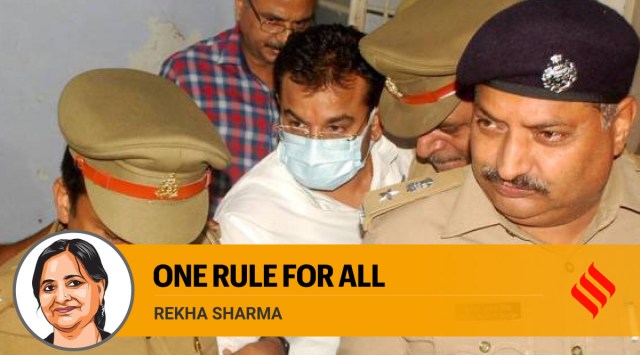
Almost half a century ago, Justice Krishna Iyer said, “Bail, not jail, is the basic rule”. It was like a sermon preached and forgotten till an industrialist of repute was granted bail at midnight, and much later, when it was resurrected again in the case of a TV news anchor. The truth is that it has been followed more in breach than in compliance.
In November 2022, the Chief Justice of India (CJI) speaking at an event organised by the Bar Council of India stated that the higher judiciary is flooded with bail applications due to reluctance at the grass root levels to grant bail. Again, in a matter coming from the Allahabad High Court, the Chief Justice was constrained to remark, “If we do not act in matters of personal liberty and grant relief, then what are we doing here?”
While ordinary citizens, human rights activists, writers, teachers and even press reporters languish behind bars, and their families suffer outside, the courts, by and large, ignore or refuse to follow the basic rule of bail. As per the statistics provided by the National Crime Records Bureau (NCRB), as on December 31, 2021, out of a total of 5,54,034 prisoners, 4,27,165 are undertrials. In other words, more than four lakh accused are languishing in jail without bail, waiting for their trial to either commence or conclude, they don’t know when. All this, despite what was clearly declared by Justice Iyer half a century ago and despite, much later, the Supreme Court’s elaborate guidelines regarding arrest and bail in Satender Kumar Antil v CBI.
On March 31, a bench headed by Justice Sanjay Kishan Kaul expressed strong disapproval over magistrates not following its guidelines, and warned that if they are passing orders in derogation of the law laid down in the said judgment, then they should be sent to judicial academies for upgradation of their skills. So far so good. But, then, with the greatest of respect, what about the Supreme Court itself where hundreds of bail applications, and a large number of habeas corpus petitions are believed to be awaiting disposal? Given the observations of the CJI in the Arnab Goswami case that “deprivation of liberty for a single day is a day too many”, these are huge numbers.
In the midst of this depressing scenario, comes the case of Ashish Mishra, son of a Union minister. Not very long ago, he was in the eye of a storm for having allegedly run his SUV over a group of farmers who were returning from a protest site in Lakhimpur Kheri, Uttar Pradesh. The incident resulted in the death of eight people while many others sustained injuries. Despite the gruesome nature of the crime, the UP police dragged its feet in arresting him. It was only after a PIL was filed in the Supreme Court against the inaction of the police, and after serious concerns were raised regarding the fairness of the investigation, that he was arrested. However, the accused succeeded in obtaining bail from a single judge of the Lucknow bench of Allahabad High Court. Once again, the Supreme Court was approached. The matter came up before a Bench headed by Justice Surya Kant.
The bench castigated the high court, and held that it failed to look into aspects such as the nature, gravity and severity of the offence, and the likelihood of the accused fleeing from justice or tampering with the evidence, as also the impact his release may have on the trial, and society at large. Holding that the high court adopted a myopic view of the evidence, it cancelled Ashish Mishra’s bail. The order went a long way towards dispelling the impression that while the high and mighty get their way, lesser mortals suffer. Thereafter, Ashish Mishra again moved the high court for bail, but it was dismissed. Hence he moved the Supreme Court.
Though the said application before the Supreme Court is for regular bail, and is yet to be finally decided, Ashish Mishra has been granted interim bail. The order comes as a surprise, to put it mildly. The accused has been granted bail on two grounds. First, he has been in custody for more than one year. Second, the trial is likely to take a minimum of five years. And, to allay the apprehension of the State that if released on bail, Ashish Mishra might derail the trial, the court said that it was passing the order on experimental basis to judge whether there is any substance in the apprehensions expressed on behalf of the State and the informant. The bail was earlier rejected on sound and valid grounds by the same bench. They still exist. It is a case where allegedly not one, not two, but a number of persons were killed, and more than one was injured in broad daylight. Just because the accused has been in custody for a year or so does not wash away the validity and relevance of the grounds for earlier rejection of bail. As for the five-year period, with respect, given the background, should that have been a consideration at this stage?
Secondly, what prevents the Supreme Court from ordering day-to-day proceedings? And as regards the release on experimental basis, what if it is ultimately found to have failed? Will the court in that case be able to undo the resultant harm?
Let us hope that the experiment leaves the law better and not bitter. Let us also hope that all accused who are involved in similar or in lesser offences than Ashish Mishra and are in jail, receive the same priority, and no one has to live with the feeling that they are children of a lesser God.
The writer is a former judge of the Delhi High Court